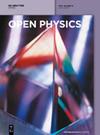纳米材料在非牛顿液体流向可拉伸表面过程中的研究
IF 1.8
4区 物理与天体物理
Q2 PHYSICS, MULTIDISCIPLINARY
引用次数: 0
摘要
这篇文章介绍了受浮力驱动的电-磁-流体力学微极纳米材料流与运动微生物之间的关系。流动是通过拉伸表面产生的,能量关系包括热源产生、磁流体力学和辐射。研究还考虑了布昂尼奥尔诺纳米材料模型(包括热扩散和布朗扩散)以及化学反应和生物对流方面的问题。非线性控制表达式被转换为无量纲系统,并使用数值微分求解方案计算无量纲表达式。通过图形分析,研究了液体流动、微浮速度、微生物浓度和温度与次要变量的关系。结果表明,哈特曼数越高,对温度和速度曲线的影响就越大。物质变量的增加导致微气浮速度的下降。温度通过辐射得到提高。浓度在热泳因素和随机因素中显示出相互矛盾的趋势。运动微生物的存在降低了生物对流的路易斯数和佩克莱特数。本文章由计算机程序翻译,如有差异,请以英文原文为准。
Investigation of nanomaterials in flow of non-Newtonian liquid toward a stretchable surface
This article features the buoyancy-driven electro-magnetohydrodynamic micropolar nanomaterial flow subjected to motile microorganisms. The flow is engendered via an elongating surface, and the energy relation includes heat source generation, magnetohydrodynamics, and radiation. A Buongiorno nanomaterial model (which includes thermophoretic and Brownian diffusions) together with chemical reaction and bioconvection aspects is pondered. The nonlinear governing expressions are transfigured into a dimensionless system, and the dimensionless expressions are computed using the numerical differential-solve scheme. Graphical analyses are conducted to examine the liquid flow, microrotation velocity, microorganism concentration, and temperature in relation to secondary variables. It is observed that a higher Hartman number has an opposite influence on temperature and velocity profiles. A rise in material variables engenders a decline in microrotation velocity. The temperature is enhanced through radiation. The concentration shows conflicting trends for both thermophoretic and random factors. The presence of motile microorganisms reduces the bioconvection Lewis and Peclet numbers.
求助全文
通过发布文献求助,成功后即可免费获取论文全文。
去求助
来源期刊

Open Physics
PHYSICS, MULTIDISCIPLINARY-
CiteScore
3.20
自引率
5.30%
发文量
82
审稿时长
18 weeks
期刊介绍:
Open Physics is a peer-reviewed, open access, electronic journal devoted to the publication of fundamental research results in all fields of physics. The journal provides the readers with free, instant, and permanent access to all content worldwide; and the authors with extensive promotion of published articles, long-time preservation, language-correction services, no space constraints and immediate publication. Our standard policy requires each paper to be reviewed by at least two Referees and the peer-review process is single-blind.
 求助内容:
求助内容: 应助结果提醒方式:
应助结果提醒方式:


